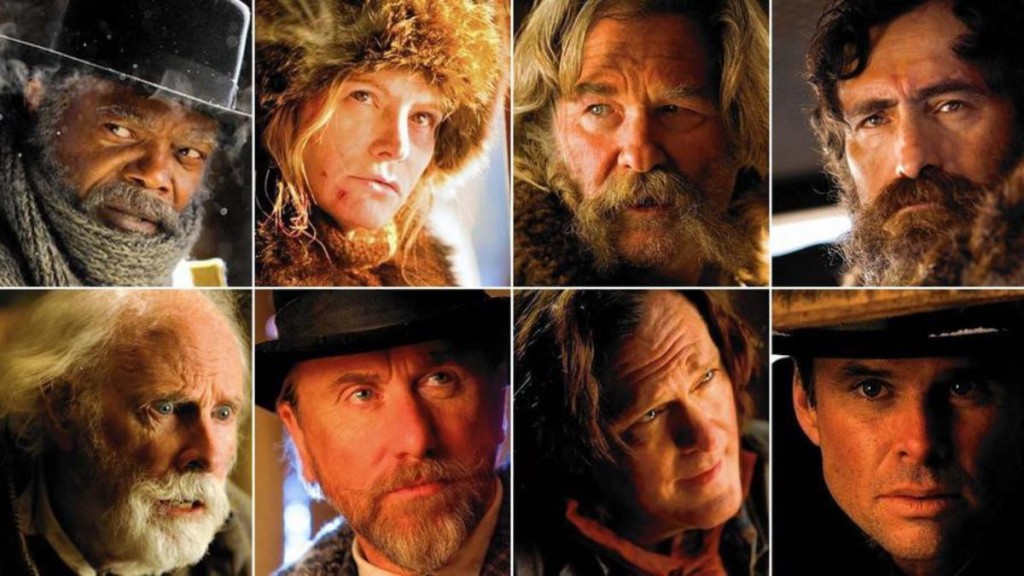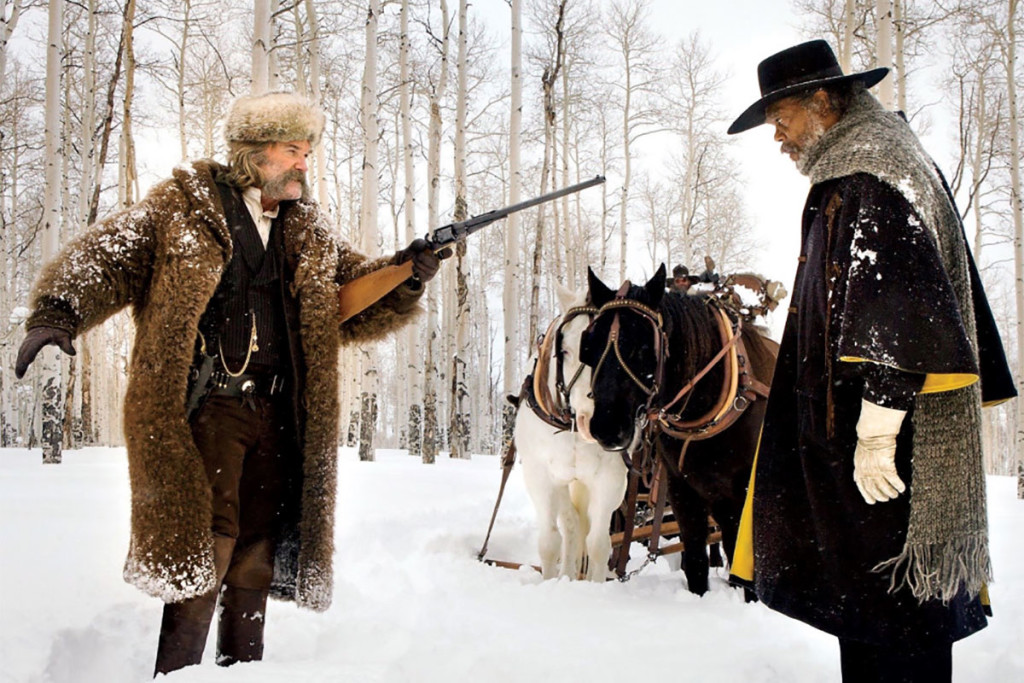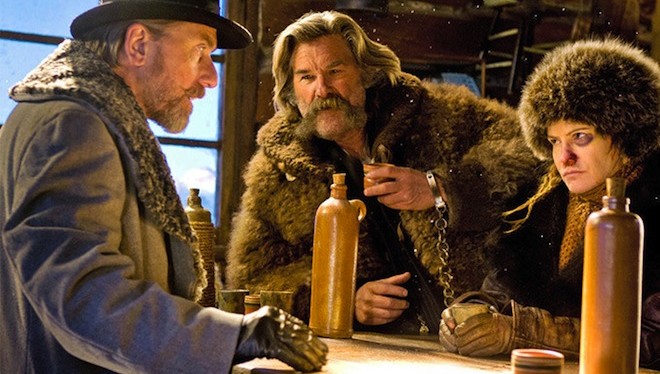Guest reviewer Chase Kimball had high hopes for Quentin Tarantino’s latest film. However, he found that there was much left to be desired when it comes to The Hateful Eight*.
by Chase Kimball
To paraphrase Yeats slightly, I need to prove that I love Quentin Tarantino movies the way a hawk needs to prove that it’s no sparrow. I have been excited for The Hateful Eight for nearly two years now. When I read that Tarantino, with the audacity of the true auteur, was planning on doing a roadshow version in 70mm, I made it my mission in life to see that version.
The dream came true at the Disneyworld Theater in Orlando. The theater screen was almost big enough to justify the hoopla of 70mm, and I was prepared to accept a few minor issues to see the movie as Tarantino intended. I have seldom been as disappointed as I was that night.
Initially, there is much to praise. The movie starts with beautiful barren snow vistas in Colorado, and they are truly stunning. Tarantino uses long static establishing shots of the mountains to excellent effect, almost rivaling David Lean’s stellar use of the desert in Lawrence of Arabia.
The 70mm format is superb for this, and Tarantino knows how to make it work. The general cinematography in these exterior shots is gorgeous, and brings home the effectiveness of 70mm for these specific purposes.
Having said this much, these early exterior shots are about all I have to rave about. The movie is around 80 percent interior shots inside “Minnie’s Haberdashery,” and the expanded format is not noticeably more effective in the interiors. So why the insistence on 70mm in a movie that is mostly interior shots?
I drew the conclusion that Tarantino had succumbed to hubris and his insistence was not audacious, but wasted. It reminds me a bit of the controversy Francis Ford Coppola endured when he shot his bomb One From The Heart in the equally old-fashioned 1:37 to 1 format back in 1981, which was also largely pointless.
The first problem I had with the movie was the issue of Jennifer Jason Leigh’s black eye. I am open to the suggestion I am nitpicking, but it was so stupid, and pointless, that it took me right out of my suspension of disbelief and set me up for noticing other problems. In short, Leigh’s black eye was a perfect oval of black makeup, which is absurd. It had all the subtlety and imagination of the black ring around the left eye of Petey the Dog in The Little Rascals.
I invite you to spend a few seconds perusing black eyes in Google Images. Black eyes are mostly hues of purple, and they are asymmetrical. One can only surmise that the makeup artist was someone who had never seen a black eye, and lacked the imagination to actually look at a picture of one.
But I had barely noticed the silliness of the black eye when big problems started, namely the horrendous treatment of Leigh as the prisoner of Kurt Russell. She starts mouthing off, and he immediately throws a vicious left elbow to her face. I found it very disturbing.
For the entirety of the movie she is treated with cruelty and contempt, starting with the elbow, then having food thrown all over her, then the crowd-pleasing projectile blood vomit in her face, and finally her torturous death.
I can’t help wondering if part of Tarantino’s recent public relations problems with police stem from a belief that modern cops treat their prisoners with the cruelty that his bounty hunter characters displayed towards their prisoners.
But if Russell is one of the major characters of the piece, and he is despicable and cruel, then whom do we have a rooting interest in? The answer is: “no one.” There is not one major character in the movie that an ordinary person would have any interest in.
Russell treats Leigh with casual cruelty, and the other major character, Samuel L. Jackson, tells a long and utterly repellent story of the death of Bruce Dern’s son, in order to goad him into a fight. I despised Jackson’s character after that story, and was complacent watching him die in bloody agony.
Nor do any other of the “Hateful Eight” stir any interest in their well-being. They all die in various violent fashions, and I was unmoved by any of it. I may have cried when Old Yeller died, but none of these characters, or their deaths, interested me for a second.
I don’t understand how one can expect to have a successful movie when every single one of the main characters is loathsome, and this is another defect I chalk up to Tarantino’s hubris, a characteristic that usually serves him well, but this time led him seriously astray.
Nor could you just let yourself be carried away by the ensemble acting. Bruce Dern was the only actor who gave a strong performance, and he was also the most sympathetic of a thoroughly unsympathetic lot.
Jackson and Russell were adequate, as were most of the others. But Tim Roth seemed to be in a different movie than everyone else, his crude humor was jarring, and, like Leigh’s black eye, he took me right out of the experience.
The death and violence were also disturbing, and pointlessly so. Since I love Tarantino movies I am not typically disturbed by violence, but this took everything to a new level. You may remember in Pulp Fiction, when Bruce Willis stabs the murderous redneck with the sword, the stabbing itself is offscreen.
When John Travolta accidentally shoots the guy in the back seat we are not treated to his exploding head. That all must have seemed quaint to Tarantino in retrospect, because now we get exploding heads and shot up/hacked up bodies aplenty to make up for it. And because even the excitement of exploding heads can begin to pall after a while, we are treating to the dying Kurt Russell vomiting blood in Leigh’s face.
I don’t know why projectile vomiting is such a popular plot point these days, because to me it just seems lazy and childish. Yes, I am aware that there are “humorous” scenes of projectile vomiting into one another’s face in Don Quixote, but I don’t think it works as a plot device for Cervantes either. And if Cervantes can’t make it work, I don’t know why Tarantino thinks he can.
A few last issues. A lot is made of the addition of the great Ennio Morricone as the composer, but for the most part the movie is devoid of background music. There are a couple of folk songs played, and there is some music while one of the characters is dying the usual bloody death, but except for the overture very little is heard from Morricone. The Mission it ain’t.
The movie itself is much too long, there are many extended, theoretically expository scenes which should have been trimmed. For the most part these scenes were dedicated to explaining how horrible the characters were, and add significantly to the 187 minutes of the roadshow version.
A more disciplined director could have easily cut the running time to two hours, and strengthened the movie while doing so. Two easy examples; all the fuss about nailing the door shot was, for me, pointless. The extended scene of running the rope to the outhouse was thoroughly superfluous.
As the movie ended the mood incited lusty cheering and clapping from the audience, who found it such an uplifting experience that their enthusiasm could not be contained. So maybe I am an outlier, and the average person will find The Hateful Eight an invigorating experience.
But I hope not.
*For another take on The Hateful Eight, check out Shimbo’s review at FlickSided.
Chase Kimball is an attorney with Lewis Hansen in Salt Lake City. He can be reached via email at ckkimball@gmail.com




